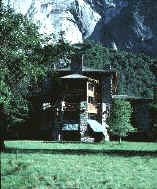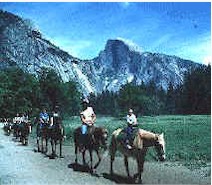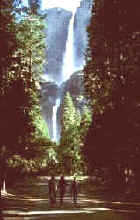YOSEMITE'S FIRST CLASS OFF SEASON
by Louis BignamAs National Parks become more crowded, off-season visits maximize pleasure and minimize crowds.
Only the off-season shows you the Yosemite which John Muir so loved. Autumn gilds meadow and woodland foregrounds against granite cliffs and animals put on their heaviest coats of the year. Winter dusts Half Dome with snow and, while skiers flood cross-country trails and Badger Pass downhill runs on the valley rim, the floor remains serenely uncrowded. Early spring visits find waterfalls at maximum flow and meadows greening up for the crowds to come. Stroll to Yosemite Falls sans crowds, watch deer and wildlife prepare for cold weather or just savor the valley. Add savings on lodgings after November 1 and an easy drive in over highways that rarely require chains and you simply lack an excuse to visit America's favorite alpine valley.
Our family love affair with Yosemite goes back to Father's first ride into the valley in 1897 on a sheepherder's wagon. I remember he walked three miles to and from work at the University of California during WW II so we could save gas stamps for our vacation visit to Yosemite. Valley visits continued during the 50's, and we still miss the "firefalls" when rangers would call "let the fire fall, and they'd push coals and such off the top of the rim. These days such things are not Politically Correct.
Like many I switched to the Yosemite high country to avoid the crowds of the 60's and 70's. When I discovered trout fishing at Yosemite peaks in the fall, and the cross-country ski track system offers lovely winter diversions, my wife, Annette and I returned to my favorite valley to survey changes for ski articles.
We discovered a Yosemite dressed in clean skirts to welcome visitors. A Yosemite with a one-way road network to eliminate summer gridlock and improve off season vistas at the price of a little map reading to avoid spousal comments such as "Dear, that's the second time we've passed Yosemite Falls."
We found campgrounds with clean, well-spaced sites and well-cared for public facilities. Both seem major improvements over the old "jam them in" sites at the price of reservations during peak periods.
We enjoyed a wide range of accommodations and food. What we couldn't find was a beer can, soda bottle or trashed garbage can in the whole valley. A deposit requirement solved the litter problem; relocating garbage-eating bears improved sanitation and visitor safety.
Yosemite Lodgings
While it's easy to drive on uncrowded valley roads during winter off season, last visit we parked at the classic Ahwahnee Hotel built in 1927. It may rank as the best-run hotel in any National Park. Shuttle buses took us to downhill and cross-country skiing, ice skating and it's a quick and easy drive to other activities such as the the Mariposa Grove's giant sequoias just an hour from the valley. These offer snow-dusted solitude in the winter.

The queen of Yosemite.
PHOTO CREDIT: ANNETTE LUCIDO
During our traditional anniversary room-service dinner, a very special meal indeed at the Ahwahnee, our waiter noted, "flatlanders own Yosemite during the summer; locals take it back in the autumn and don't give it up until spring ends." Such definitely seems the case, but we plan to steal a bit of Yosemite for ourselves at least once a winter. If possible, we hope to stay at the Ahwahnee, which is tucked away on its own spur road for more privacy and less traffic.
Accommodations run over $100 a night, but you enjoy the finest accommodations in the Valley. Even if you don't lodge there, you should consider a meal in the massive main dining room. We've enjoyed afternoon high teas, lovely public rooms and impeccable service here. Special activities include wine tasting weekends and the exceptional Christmas dinner. Reservations at least 14 months ahead are always required! For example, the Christmas dinners fill at least one year ahead!
The Yosemite Lodge offers typical motel-type accommodations, a central location and lovely views of Yosemite Falls and El Capitan. Other Curry Company lodgings offer a wide range of accommodations. RV campgrounds with hookups can be found just outside Yosemite at Wawona, El Portal or Yosemite West .
Eating Yosemite
Valley meals generally reflect the quality associated with the lodgings. The Ahwahnee's dressy Main Dining Room requires a coat, and food and prices rank with San Francisco's best. Save with less expensive breakfast visits and enjoy the splendid view of El Capitan from the dining room. In milder weather, visitors enjoy drinks or snacks on the deck behind the hotel. Curry Village has fast and cafeteria food; Yosemite Lodge feeds guests at two restaurants, a cafeteria and an ice cream parlor.
Like lively nightlife? You're on your own. We always spend so much energy skiing, fishing or hiking during the day that we're too beat to do much more than watch the scenic films at the hotel. We know naturalists give talks, and ski buffetts and meet-your-instructor ski nights happen, but not for us. 
Guided horse trips let the valley's treasures unfold at a proper pace.
PHOTO CREDIT: ANNETTE LUCIDO
Like most return visitors we observe a traditional pattern after we unpack in fall or spring. We work out travel kinks with a short hike up to Mirror Lake around Washington Column to Happy Isles where we catch a shuttle bus back to Curry Village or our lodgings. The shuttle passes the stables where well-behaved horses and burrows wait to give rides to spring or fall visitors. If you wish to enjoy the splendid Yosemite backcountry come summer, you need to book a Ranger-led High Sierra Camp or private pack trip now. In fact, even backpackers need summer reservations to avoid congestion.
If you plan a fall horse or backpack trip you can avoid crowds and enjoy the prime Indian summer weather usual after Labor Day. We used to backpack often, but always carried a radio for weather reports as you must sometimes rush to the road when a storm heads in. Do check the weather before and during your trip so you can avoid the need for chains.
First time visitors should drop into the Visitor Center and pick up a copy of the informative Yosemite Guide which details seasonal offerings. The valley shuttle tour takes a couple of hours and seems the best way to discover the valley. Keeping eyes on the road as you drive definitely tests your concentration! An audio-visual presentation, dioramas and other exhibits explain the unique glacier-scoured geology of the valley and show how its small area relates to the many times larger Sierra High Country beyond the rim.
Curry and Yosemite Villages offer all services, shopping and more so you need not rough it in the valley even in winter. We do find Yosemite food and other prices on the high side, so we buy supplies in valley towns such as Merced or Fresno when we drive into Yosemite.
My favorite activity, trout fishing, starts well downstream near El Portal on the Merced River from the more populated East End of the Valley. I find trout anxious to hit a fly or lure in the fall and cooperative during winter and early spring in the special regulations areas. Light gear and insulated waders suit cold water, but the big problem for me remains concentration. Even compulsive trout addicts find it tough to keep the head down and eyes on the hatch when El Capitan looms over the water. Better backcountry fishing in High Sierra lakes seems the summer choice.
My wife would rather hike than fish. She claims, "we get fish at home, but you can't walk through scenery like this anywhere else in the world!" All sorts of short trails suit hikers. Start in mid-morning so any ice melts, wear warm, waterproof shoes and plan to return before 3 in the afternoon to avoid evening chill and you can enjoy all sorts of trips.

Every tour should include a walk up to Yosemite Falls.
PHOTO CREDIT: ANNETTE LUCIDO
Annette's favorites include "baby hikes" such as the easy walk into the wildly varied ice cornices at the base of Yosemite Falls, several loops to Mirror Lake and a variety of trails through valley meadows and woods along the Merced River. Guided hikes with a naturalist can add special flavor and a lot of information to your hiking day.
Yosemite's No Snow Show
You can hike most days even in winter because it only snows enough to stick on the valley floor three or four times each winter. So don't expect snow in the valley. Only lucky visitors enjoy the chance to photograph snow-covered valley vistas or ski or snowshoe along meadow hiking trails. You can, however, enjoy scenic ice skating (rentals available) on an outdoor rink morning, afternoon or night under Glacier Point. Do, if the moon's up, consider moonlight skates or strolls. Don't forget gloves and a down jacket!
Most winter visitors to Yosemite spend their days at the snow sports center Badger Pass, the oldest ski area in California, which suits beginners and intermediates. It offers more of a settled, European ambiance than most ski areas. It's just 23 miles from the valley via a shuttle bus. Family skiing doesn't get much better and kids can't stray as far as at larger areas. Area ski instructors seem especially patient with older skiers new to the sport. Packages which include lessons, lift tickets etc. can cut your costs here. Special kids' packages let the small fry learn fast and free parents so they, too, can enjoy their downhill day.
Nice Nordic
The Nordic Area offers 10 miles of tracks leading to Glacier Point's incredible winter vistas. Tracks keep skis pointed in the right direction and reduce your effort per mile. Over 90 miles of trails wind through the rim and through the Mariposa Grove of Big Trees. First time skiers should start with a package that includes lessons and rentals to reduce effort and risk of injury. More experienced x-c skiers can, snow conditions permitting, enjoy snow camping, winter survival seminars, overnight ski trips and, for the skilled and hardy, Trans-Sierra slogs. Visitors new to snow country might rent snowshoes for short, quiet jaunts beside cross-country trails. Trips longer than a couple of miles can leave you walking like a cowboy, but risk of injury seems minimal. Frankly, cross-country skiing is less work and safe if you start with lessons. Start with Ranger-led snowshoe hikes or Yosemite Mountaineering excursions.
More sedentary visitors can ride the rather noisy snow cats from Badger Pass Ski Area to the valley rim or watch the skiers from the lodge.
While many visitors never leave the valley and ski areas, a few make a side trip to Wawona and the Mariposa Grove of giant sequoias. In fall and spring you can drive too and walk through these unbelievably huge, ancient trees. Cross-country skiing through trees such as the 210 foot tall Grizzly Giant provides special pleasures. Unfortunately, our favorite Tunnel Tree, the one narrow old cars drove through, fell in 1969. But it's massive fallen trunk offers a quiet, intimate look and a chance to ski over the trunk if snow permits.
Snow, or rather its quarantine on the valley rim, makes Yosemite visits especially attractive. Drive in on Highway 41 from Fresno or Highway 120 "the Big Oak Flat Road" from Manteca and you may face snow and, at times, chain requirements. Wind in on Highway140 through El Portal from Merced and you won't even see much snow until you reach Arch Rock Entrance to the valley most years. The winding "Tioga Pass Road" to Lee Vining and Highway 395 closes in the winter. It accesses the famous High Camp Loop or day hike camps at Tuolumne Meadows.
Admittedly, Yosemite isn't uncrowded all winter. Lodges fill during holidays and some weekends after Badger Pass opens. But skiers don't stay in the valley. So you can drive in and park to take public shuttles or drive even the largest motor coach into the valley and, with an eye on the weather, enjoy Yosemite at your own speed.
INFORMATION (all area code 209)
- NATIONAL PARK SERVICE, Yosemite National park 95389
- Road information recording 372-4605
- Park Hotline camps etc. 372-4454
- Yosemite Valley Visitor Center 372-4845
- YOSEMITE PARK AND CURRY COMPANY, hotel and other reservations (252-4848) Yosemite National Park, 95389
- ART ACTIVITY CENTER (photo and art workshops through December) Yosemite Natural History Association, Box 545, Yosemite National Park, CA 95389 372-4532
- BUS TOURS (Valley floor, Moonlight, Mariposa Grove etc. subject to snow and road conditions) call 372-1240 on arrival
- TICKETRON (camping reservations up to 8 weeks in advance)
- YOSEMITE AREA TOURISM COUNCIL, Fish Camp, CA 93623 Booklet "Around Yosemite's Front Door." 683-7273
- YOSEMITE MOUNTAINEERING SCHOOL (rock and snow climbing classes) Yosemite National park, 95389
- PHOTO WORKSHOPS The Ansel Adams Gallery, Box 455 Yosemite National Park, CA 95389 372-4413
